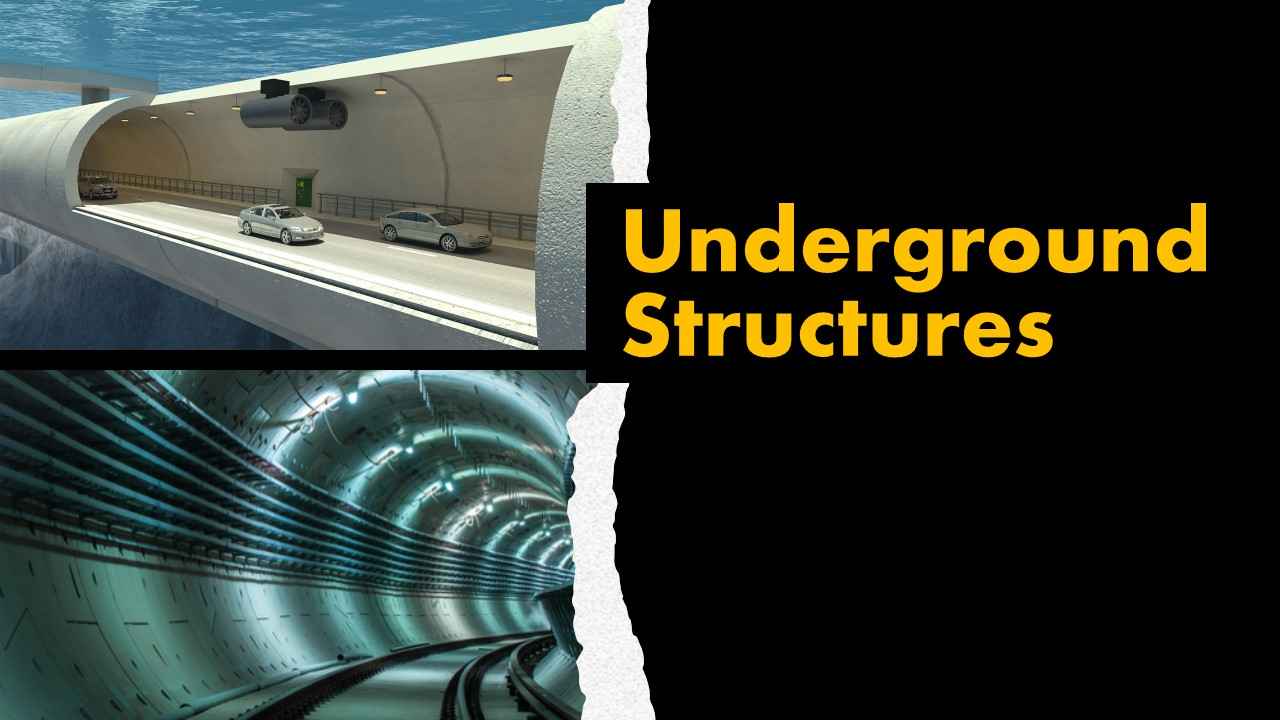Underground Structures: Exploring Subterranean Engineering Marvels
- By
- Pooja |
- February 25, 2024 |
- Civil Engineering, Construction,

Table of Contents
Subway Systems: Engineering the Pulse of Underground Transportation
The Channel Tunnel: Bridging Nations Under the Sea
The Underground Cities of Cappadocia: A Historical Subterranean Haven
The Gotthard Base Tunnel: A Modern Rail Engineering Triumph
The Shanghai Tunnels: A Historical Underground Maze
Beneath our feet lies a hidden world of remarkable engineering achievements—underground structures that range from intricate subway systems to vast networks of tunnels and even entire cities below the surface. From bustling subway systems to secret bunkers and innovative tunneling projects, the world beneath us is a testament to human ingenuity and the ability to overcome unique engineering challenges.
Subway Systems: Engineering the Pulse of Underground Transportation
Subway systems are vital components of urban infrastructure, providing efficient and rapid transit for millions of people daily. The engineering challenges associated with subway construction are multifaceted, ranging from tunneling through varied geological conditions to ensuring the structural integrity of underground stations. The London Underground, established in 1863, holds the distinction of being the world's first subway system and has since served as a blueprint for numerous others.
Modern subway systems, like Tokyo's extensive network and New York City's subway, involve intricate engineering solutions to navigate through densely populated urban areas and varied geological formations. Tunnels must be strategically placed to avoid existing infrastructure, and advanced tunnel-boring machines are employed to excavate through rock, soil, and even underwater, minimizing surface disruption.
The Channel Tunnel: Bridging Nations Under the Sea
Connecting the United Kingdom and France, the Channel Tunnel, also known as the Eurotunnel, is an engineering marvel that spans beneath the English Channel. The tunnel comprises three interconnected tubes, two for rail traffic and one for maintenance and emergencies, totalling a length of 50 kilometres. The construction of the Channel Tunnel presented numerous challenges, including tunneling through soft chalk marl beneath the seabed.
Engineers overcame these challenges by employing tunnel-boring machines equipped with state-of-the-art technology to maintain stability and prevent flooding during construction. The Channel Tunnel stands as a testament to cross-border collaboration and the ability to overcome formidable engineering obstacles, bringing nations closer through subterranean connectivity.
Read More:
The Underground Cities of Cappadocia: A Historical Subterranean Haven
Delving into the ancient past, the underground cities of Cappadocia in Turkey showcase the remarkable engineering skills of civilizations that carved entire cities beneath the earth's surface. Dating back to the Hittites in the 6th century BCE, these subterranean cities served as hiding places during times of war and provided shelter from the harsh Anatolian climate.
The underground cities are an intricate network of tunnels, chambers, and ventilation shafts, designed for both practical and defensive purposes. Carved into soft volcanic rock, these cities are an astonishing example of how early civilizations harnessed their environment to create secure and habitable spaces beneath the ground.
The Gotthard Base Tunnel: A Modern Rail Engineering Triumph
Opened in 2016, the Gotthard Base Tunnel in Switzerland holds the title of the world's longest and deepest rail tunnel, stretching over 57 kilometres beneath the Swiss Alps. The tunnel represents a pinnacle of modern engineering, overcoming geological challenges associated with tunneling through the complex Alpine rock formations.
The Gotthard Base Tunnel features state-of-the-art tunnel-boring machines and an intricate ventilation system to maintain air quality and regulate temperatures in the tunnel. It significantly reduces travel time between southern and northern Europe, demonstrating how subterranean engineering can enhance connectivity and efficiency on a continental scale.
Read More:
The Shanghai Tunnels: A Historical Underground Maze
Beneath the busy streets of Shanghai, a network of tunnels known as the Shanghai Tunnels has a rich history dating back to the 19th century. Initially constructed for transportation and cargo, these tunnels later became infamous for their association with human trafficking and the opium trade.
The Shanghai Tunnels present engineering challenges related to preserving historical structures while adapting them for modern use. Today, efforts are underway to restore and repurpose parts of the tunnel system for cultural and tourism purposes, allowing visitors to experience the unique blend of history and engineering innovation beneath the city of Shanghai.
Unbelievable underground structures span the spectrum of human history and achievement, from ancient subterranean cities to cutting-edge modern tunnels. The engineering challenges involved in creating these marvels are as diverse as the structures themselves, requiring innovative solutions to navigate through geological formations, urban landscapes, and historical contexts. As technology continues to advance, the world beneath our feet will likely witness even more remarkable feats of subterranean engineering, shaping the way we connect, travel, and live in the depths of the Earth. The subterranean realm is a testament to the indomitable spirit of human ingenuity, forever pushing the boundaries of what can be achieved beneath the surface.
Please feel free to like, share and comment.
Admin, gcelab.com Please see our Pillar Post to know why we founded gcelab.com.
Read More:

Pooja
Founder at gcelab.com, Pooja is an Entrepreneur unlocking human potential. Working in the Principles of Lean Start-up, Pooja believes in Transparency and User Happiness the most. Pooja’s background in teaching gives her a sophisticated grasp on even the most tedious aspect of course building. She is passionate about people who believe that good is not enough.
Previous Post
Unconventional Materials in Construction
Next Post


